Dehydrating herbs is a great way and one of the simplest way to preserve your fresh herbs for use year-round. Whether you grow your own herbs or store-bought leftovers, surely you want to avoid spoilage and wastages. Dehydrating or drying herbs removes the moisture and it is in the dehydrated form that your herbs will keep longer. Moreover, when the season changes you need not worry about difficulty buying or growing.
While there are several ways to dehydrate herbs, by far, a food dehydrator works best. Why? You can read more about it here.
Let’s discover the best food dehydrator for home use.
Before that, do you know there are two main types of food dehydrator? It is good to know and understand how they work so that it is easier for you to shortlist which type of food dehydrator to go with.
Vertical vs Horizontal Flow Food Dehydrator
Vertical flow food dehydrators are also known as stacked food dehydrators. The heat source is located at the base or top of the dehydrator. While it works well for most vegetables, fruits and herbs, you may have a harder time with meat jerky because the heat does not spread evenly.
However, this does not mean getting a vertical flow food dehydrator is not a good choice.
The solution is switching the trays manually during the dehydration process. A little bit of manual effort is needed but good to know that vertical food dehydrator is more affordable than the horizontal unit. Some models do include a fan to help with the heat distribution.
If you have limited kitchen counter space, the vertical unit is small and compact. On top of that, is it expandable meaning you can buy more trays to add over time.
Horizontal flow food dehydrators are also referred to as box food dehydrators. The heat source is located in the back thus allows heat to distribute evenly and efficiently throughout the unit. This makes it more expensive. On the plus side, it is ideal for dehydrating meat and tougher vegetables without the need to monitor and manually switch the trays to ensure even drying.
Box food dehydrator is larger in size hence you may require more counter space.
Things to Consider When Buying Yours

Buying the best food dehydrator depends on your needs, mostly how you plan on using it. I am sure you want to get the most out of a food dehydrator without breaking a bank while not compromising the quality of your food. Here are a few things to keep in mind when choosing yours.
1. Airflow and Heat Distribution
What type of food do you intend to dry mostly? As mentioned above, the stacked dehydrator is not efficient enough to dry meat because the heat source at the base does not distribute heat evenly. However, it does a good job with vegetables, herbs and fruits.
But then you like to have a stackable dehydrator for certain reasons and also need one that dehydrates meat – thinking of your beef jerky, aren’t you? Well, technology has improved significantly over the years and manufacturers come up with design elements to improve the airflow of the vertical flow or stacked dehydrators. Therefore, this is what you need to look out for.
2. Temperature Control
This is another important element to look out for.
Different types of food dehydrate under different temperatures. Therefore, you must be able to adjust the temperature in order to achieve the best results. Most models allow you to dehydrate at a temperature range of 95-160°F.
Avoid buying food dehydrators that do not have an adjustable thermostat. Cheap dehydrators normally don’t.
3. Size, Capacity & Space Saving
How much food will you be wanting to make in one batch? And do you have enough kitchen counter space for another appliance?
A stackable unit has a smaller footprint and easier storing it but this means smaller capacity. You must be willing to take time making several batches.
4. Noise
Food dehydrators that come with a fan will produce some noise. Since dehydrating food can take hours, this is an important element to check for anyone who may be noise sensitive.
The decibel level will differ for each model and unfortunately, the decibel ratings are not normally listed in the product specifications. In this case, you may have to check out consumer reviews to find out what people are saying about the noise levels of the dehydrator you have in mind.
5. Good to Have Features
Timer. As I have mentioned, food dehydration takes hours, hence there is a possibility you may forget all about it. A dehydrator with a timer will come in handy, ensuring you check on the drying progress and know when it is ready.
Auto Shutoff. You do not want to wait for hours until it is done. Start the dehydration process and go run your errands. Or start the process before going to sleep at night. An auto-shutoff feature is good to have.
6. Price
The price of a food dehydrator for home use can range anywhere from $30 to over $300.
The lower-priced dehydrators are mostly basic units for drying certain food only. The limitation on types of food you can dehydrate is due to the lack of efficiency of the airflow and heat distribution. It also takes some effort and your time managing the drying process, switching the trays and always keeping an eye on the entire process.
On the other side of the scale, higher-priced food dehydrators allow you to dehydrate various choices of food including meat. The airflow and heat distribution ensure everything is dried evenly. Added features of the adjustable thermostat and timer make the entire process hassle-free.
In Summary
A question only you can answer – how will you use your food dehydrator?
If you are a huge fan of herbs and would like to preserve your fresh herbs for year-round use, a stacked unit would suffice. The best food dehydrator for herbs need not be on the higher end of the price range. However, pay a little bit more for the added features if your budget allows. An adjustable thermostat to control the temperature is a must if you ask me. Also, take into consideration the space needed for an additional appliance, not forgetting the noise level if you are a noise-sensitive person.
If your intention of buying a food dehydrator is to dry various types of food including meat or in large amount, when you have a garden of fresh herbs waiting to be harvested and dehydrated, it is worthwhile investing in a better unit. Box food dehydrator is more efficient ensuring different kinds of food are properly dehydrated with ease. You need not spend time monitoring and moving the trays up and down. Do think of the space needed for a bigger unit.
First-time buyer? You don’t have to start with an expensive or high-end model. Understand your needs and find an ideal food dehydrator for home use which normally falls somewhere around $50 – $150.
Now that you have a very good idea of what you want and things to look out for, let’s find out what your options are.
Best Food Dehydrator for Home Use
Take a quick look at what’s coming
At A Glance

Now that you have seen a bit of each, let’s see how each machine fair and helps you in your food dehydration needs.
1. Presto Electric Food Dehydrator, Standard
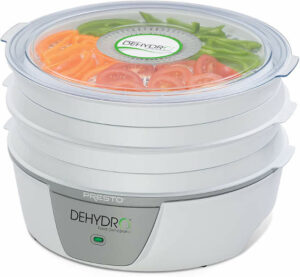
Rated 4.5 out of 5 stars with 4,985 customer reviews
Product Dimension: 14.5 x 15 x 6.25 inches
Power: 600 Watts
This 4-tray stackable model is the most basic. Although the heating source is located at the base, a bottom-mounted fan provide consistent airflow for optimum drying.
The good. The see-through cover allows you to monitor the drying process. It is also dishwasher safe along with the drying trays. Need additional trays? They are sold separately and you can stack up to eight trays.
If you have limited kitchen counter or storage space, you will be happy to know the drying trays nest for compact storage. And no more tangles – the cord stores in the base of the unit.
The bad. It does not have an on/off switch meaning this unit turns on when plugged in. Also, it does not have an adjustable thermostat and timer. This dehydrator operates at a preset temperature of approximately 165°F.
Overall. Priced around $40, this is one of the most economical food dehydrators. While this model is good enough to dehydrate certain food, I would not recommend dehydrating herbs. With no temperature control and preset at around 165°F, it will cook the herbs. You only want to dry and preserve your herbs, without affecting the nutrition and medicinal value. The ideal temperature for dehydrating herbs is between 95-115°F.
Nonetheless, this model is great for first-timers wanting to try dehydrating food. It is a good price and you can experiment without spending a lot of money.
If dehydrating herbs is your priority and you have a little bit more to spend, take a look at the next model.
2. Presto Digital Electric Food Dehydrator

Rated 4.5 out of 5 stars with 2229 customer reviews
Product Dimension: 14.5 x 15 x 7.25 inches
Power: 750 Watts
The key difference between this and the standard model above is that you get to control the temperature. It comes with a digital thermostat allowing you to dehydrate at a temperature range of 90-165°F and a timer for precise drying.
This model is expandable to 12 trays, 6 is included when you buy this Presto Digital Electric Food Dehydrator. Also included are two fruit roll sheets for making fruit rolls and two non-stick mesh screens for drying small and sticky food.
The good. Being able to control the temperature means you get to dehydrate many more types of food including meat (if you must have your beef jerky) or the delicate herbs.
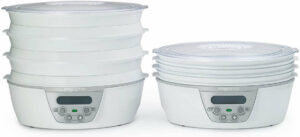
When not in use, the drying trays nest for over a 40% reduction in storage space.
The bad. It was mentioned no tray rotation necessary because it comes with a bottom-mounted fan but a few customer reviews encourage users to rotate them to ensure even drying. Also, a customer suggested placing the harder or thicker food at the bottom with the more delicate on top. I say these are very good suggestions.
You have to know that this dehydrator is a little bit noisy but most models are. The fan helps the airflow and heat distribution hence the noise.
Overall. Doubled the price of the standard model, is this worth buying? You can get a lot more out of this model which comes with the adjustable thermostat and timer. For around $80, more choices of food can be dehydrated with ease. If you have a problem with storage space, this model would be wonderful to have.
3. Cosori Dehydrator Machine

Rated 4.7 out of 5 stars with 1126 customer reviews
Product Dimension: 13.8 x 11.8 x 13.8 inches
Power: 450 watts
Comes with adjustable thermostat, this 5-tray stackable model allows you to set the temperature in the range of 95-165°F. Also includes one mesh screen and one fruit roll sheet.
The good. This model has a countdown timer and auto-shutoff so you need not worry about forgetting and over-drying your food. Cosori food dehydrators are one of the few machines that record the lowest noise level.
The bad. Be aware, you may miss the fine print. Although it is stated the trays are dishwasher safe, they are to be washed on the TOP rack if you remove them BEFORE the drying cycle.
Overall. I dislike complicated buttons on any appliances and this Cosori food dehydrator features 4 digital buttons. However, they are pretty easy to use and once you have figured those out, it gives you full control over dehydrating your food. With adjustable temperature and digital timer, this machine is easy to use for beginners. Moreover, the recipe book included has 50 dehydrator recipes thus you need not do any guesswork and start dehydrating straight away. The price is very affordable at around $70 considering all the features.
4. Nesco Snackmaster Pro Food Dehydrator FD-75A

Rated 4.6 out of 5 stars with 8107 customer reviews
Product Dimension: 13L x 13W x 11H inches
Power: 600 Watts
Nesco is one of the most popular brands in the food dehydrator market. They have a range of vertical flow models and some are fairly affordable.
This Snackmaster Pro has an adjustable thermostat allowing you to dry different foods at a proper temperature between 90-160°F. It comes with 5 trays and you can expand them up to 12 trays. Also includes two fruit roll sheets, two clean-a-screens, a sample of jerky seasoning with cure, and a recipe book.
The good. Its top-mounted fan together with the Coverga-Flow drying system helps ensure even heat distribution drying without having to rotate trays.
The bad. It does not have a timer. Well, you can always use your alarm clock or mobile as a timer.
You will notice the background white noise but it is quite similar to a small desk fan. If you are not too sensitive, it is bearable.
Overall. Priced around $90, this may not be one of the cheapest food dehydrator but definitely worth considering. Even though without a timer, being able to control the temperature coupled with its Converga-Flow system, you get to dehydrate a large variety of your favorite food.
If you have a tight budget or trying to figure out if dehydrated food is your thing, check out the basic version, without a thermostat, Nesco FD-37 Food Dehydrator which is around $40.
5. Excalibur 9-Tray Electric Food Dehydrator
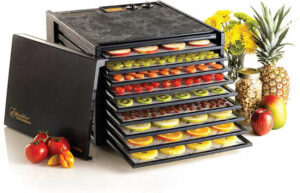
Rated 4.7 out of 5 stars with 2094 customer reviews
Product Dimension: 19 x 17 x 12.5 inches
Power: 600 Watts
Excalibur, a well-known brand selling high-end box dehydrators, has an exceptional reputation in the industry. So you expect the price to be on the higher end. Nonetheless, read on to find out what the deal is and use it to compare with other less expensive machines.
Excalibur 9-Tray Electric Food Dehydrator has built-in on/off switch, adjustable thermostat ranges from 105-165°F, 7″ fan and a convenient 26-hour timer plus auto-shutoff.
The good. This 9-tray box dehydrator has 15 square feet of drying space and offers plenty of space for a large variety of your favorite food. Its flexible poly screen tray inserts prevent foods from sticking to trays.
Excalibur’s patented Hyperwave Technology and Parallex Horizontal Airflow helps the food dehydrate faster, retain more nutrients and look and taste better, without tray rotation.
The bad. This may not be the quietest dehydrator. Similar to the noise level of a dishwasher if you do not mind the white noise during long hours dehydrating food.
Overall. With all the useful features and large capacity, this is ideal for large families, gardeners, craftspeople and sportsmen. An expensive machine at around $240, this is the best of the best food dehydrators for home use, definitely for those who are serious about preserving food.
A slightly cheaper model, Excalibur 5-Tray Dehydrator is available at around $225. It uses less electricity power at 440 watts with 8 square feet of drying space but without auto-shutoff. Take a look here.
6. Chefman Food Dehydrator
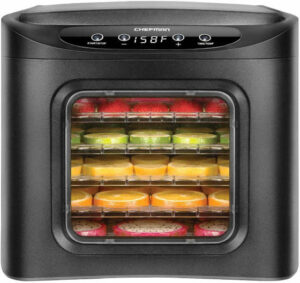
Rated 4.6 out of 5 stars with 569 customer reviews
Product Dimension: 13.58 x 17.52 x 12.4 inches
Power: 480 Watts
This 6-tray box dehydrator has digital temperature preset settings ranging from 95-158°F, integrated with a countdown timer up to 19.5 hours and automatically shuts off when the time is up.
The good. Its built-in innovated design maximizes airflow that results in an even drying without overheating ensuring the perfect dried fruit slices, long-lasting dried herbs, delicious jerky and more.
Designed with a transparent viewing window, you can keep an eye on your food during the drying process.
The bad. After scanning through most of the not so good customer reviews, I found a few similar complaints on the door. It seems a bit flimsy but with care, it is not a big issue, just be aware and ensure the door closes properly.
Overall. This Chefman Food Dehydrator has similar features of the Excalibur but at a much cheaper price at around $115. On the other hand, it is a known fact price affects quality. You may not get the best of the best but this Chefman dehydrator is a worthy buy take into consideration all the features. Moreover, a box dehydrator provides more consistent heat and flexibility than the lower-priced stacked dehydrator. Another thing to note is that the 6 trays included are BPA free plastic trays. If you are keener on stainless steel trays, check out the following – Cosori or Magic Mill.
7. Cosori Premium Food Dehydrator
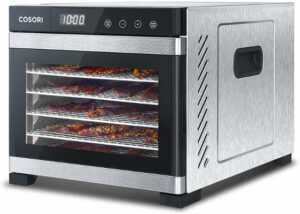
Rated 4.8 out of 5 stars with 2467 customer reviews
Product Dimension: 13.4 x 17.8 x 12.4 inches
Power: 600 Watts
This dehydrator has a digital control panel to set the timer in 30-minute increments for up to 48 hours. The auto shut off kicks in right when the timer ends. Temperatures range from 95-165°F. It comes with 6 stainless steel trays, one mesh screen and one fruit roll sheet.
The good. The auto-shutoff is a good feature to have. You need not worry about forgetting all about it after the long hours. Cosori is rated as the quietest dehydrator by Amazon Editorial Team.
The bad. The capacity may be a bit small as the tray is only at 12 x 13 inches (compared to Excalibur, 15 x 15 inches).
Similar to the Cosori Stacked Dehydrator above, remember the fine prints – trays are dishwasher safe, they are to be washed on the TOP rack if you remove them BEFORE the drying cycle.
Overall. Priced at around $170, not pricey nor cheap. It is reasonable and worth the buy if you plan on using this frequently, dehydrating a smaller batch of food.
8. Magic Mill Food Dehydrator

Rated 4.7 out of 5 stars with 582 customer reviews
Product Dimension: 14 x 17 x 16 inches
Power: 600 Watts
The preset adjustable thermostat and timing allow you to select the right temperature from 95-165°F up to 24 hours dry time. Once done, it will automatically shut off. This machine comes with 10 stainless steel trays (although it fits 9 only), 1 hanging rack, 1 fine mesh sheet and 2 fruit leather trays that can also be used as a drip tray.
The good. The hanging rack for jerky is a plus if you like making jerky. After the drying process, there is an additional keep-warm function that keeps your food warm for additional 24 hours on 95°F.
The bad. Gathered from a few customer reviews – the dehydrator is a bit flimsy when all the trays are out but with care, it is fairly acceptable. Though, outside is all plastic.
Overall. Not as cheap as some entry-level machines, but this has a bigger capacity than Cosori. Priced at around $180, this is a good option if you are dehydrating a lot of food and do it without hassle.
All in All
The best food dehydrator for home use need not be an expensive machine. Some cheaper models do the same job of dehydrating but you must look at the dehydrator’s features and select carefully.
When choosing yours, you have to know how you plan on using it. Are you going to use it occasionally or frequently? What food you will be drying?
Although a box dehydrator is better in terms of heat distribution and airflow, a stacked dehydrator is more affordable and do a fairly good job drying herbs, fruits and vegetables. Should you intend to dry meat and a large amount of food, of course, a box dehydrator is worthy.
I hope the listed food dehydrators here coupled with the things to consider when buying can help you decide which machine is best for you.
By the way, this review contains affiliate links. When you click them and make a purchase, I receive a small commission at no additional cost to you. Read about my Amazon Affiliate Disclosure here.
Related Read
There are other interesting and healthy ways to preserve or use your fresh herbs besides dehydrating. Choose your topic below or read them all.
Please Comment & Share This Article
Have you decided on your food dehydrator? Which one do you have in mind?
What are your experiences dehydrating food? Share with us in the comments section below so we can learn more.
Please share this review article with anyone that you think might find it useful.
Happy Dehydrating!
From the Corner of My Home – Spice Up Your Life with Herbs and Spices
Disclosure: This blog post may contain affiliate links as part of the Amazon.com Services LLC Associate Programs and other affiliate services. This means that cornerofmyhome.com receives a small commission by linking to amazon.com and other sites at no extra cost to the readers.




Hello there, thanks a lot for sharing this wonderful piece of information here with us. I must say i really did enjoyed going through your review as it contains valuable informations one needs to be aware of when getting one of these best food dehydrator. I think from how detailed you have summarized their features i now know which i will be getting, thanks.
You’re most welcome, Philebur. Glad this helps.
Hello there! Thank you very much for sharing this article on the best food dehydrator for herbs. I’ve gone through it and it’s a very educative one and also well detailed. You’ve done a commendable job, well done. Of course we need food dehydrator to preserve herbs to last for at least a year. The other one I got was a lie as herbs got spoilt after 3 months. I’m going to get the Cosori dehydrator machine, it’s attractive and it serves the purpose I want. Thank you
You’re welcome, Sophie.
Sorry to hear about the spoilage. Normally, herbs dried properly can last up to 6 months although the aroma and flavor may dissipate over time.
Cosori is a very good choice. It is fairly reasonable and is one of the quietest machines.
Happy Dehydrating!
Hello there, thanks for this really wonderful article. We have always needed to store food at one point in time and sometimes when you don’t have a good means to dehydrate these food substance, they end up getting spoiled and it’s really a waste of food and we don’t I’m at that. Getting the best food dehydrator for herbs here means a lot to me because I have some that I would love to preserve.
Like you, I dislike wastages. I tend to buy what’s needed and never in bulk but some fresh herbs are mostly sold in bundles. It is good to know ways to preserve herbs for later use. A food dehydrator does a very good job dehydrating herbs and many other seasonal fruits.
Thanks for dropping by, Lawson.
Happy Dehydrating!
That’s a really useful article you have here, many times I get into talks with my wife and they are sometimes about wastage of things, be it food products or even materials. It is a good thing to know how to preserve things, list especially herbs as you’ll be able to use it over the years, and these tips for the best food dehydrator are quite practical and understandable.
I am glad you find this article useful, J.
You have a good day!
What I love about food dehydration is that I can buy fruit and vegetables in their season in a cheaper price and dry them for year round use. Because of this, my own excess crops don’t get wasted. I will say that homemade dried fruit is very cheap and healthier since lots of companies make use of sulphides for preservation and high levels of sugar.
From my experience, some foods like mushrooms don’t usually last long in the fridge and they can’t be frozen because of their high water content but this makes it even perfect for dehydration. Though right now, I’m planning on getting a new food dehydration and the list you gave makes it easier to get the one of our choice.
You are right, Kelvin. Homemade dried fruit is cheaper and much healthier, all-natural. I had a few incidents fresh mushroom went bad and now I mostly use dried mushroom. They keep really well.
Thanks for commenting.
Good day!